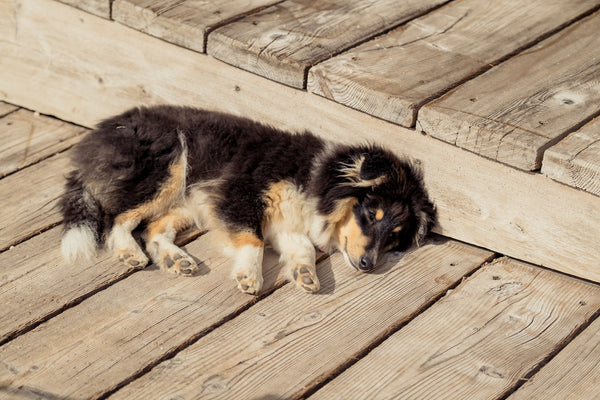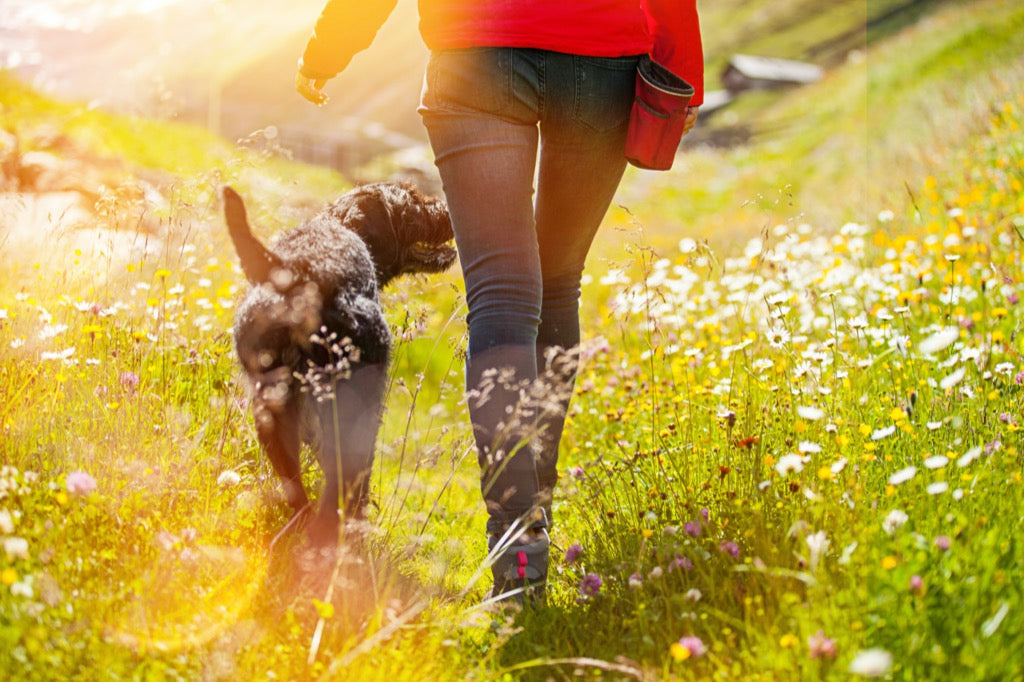Although the summer months are welcomed by most of us, it isn’t always such good news for our canine companions. Dogs are naturally prone to heat stress, and as owners it’s important for us to recognise the signs that our four-legged friend may be over-heating. We're here to give you advice on what to do if your dog suffers from heat stroke and generally how to keep them cool during the warmer summer months.
Heat stress or heat stroke in dogs is very serious and sadly can often lead to grave illness and death – a recent survey found that 48% of vets in the UK have treated dogs for heat stress during the summer months which is an astonishingly high number given how easily prevented it can be. Dogs can suffer brain damage and death from heatstroke within 15 minutes so it’s vital that you recognise the signs.

Dogs Most At Risk Of Heat Stroke
If your dog falls into one of these categories, then they deserve special attention in the hot weather.
- Dogs with dark coats - these absorb the heat from the sun rather than reflect it
- Dogs with long or dense coats
- Working or hunting dogs like shepherds and retrievers
- Overweight or obese dogs
- Dogs with existing health issues (e.g. respiratory, cardiovascular or neurological diseases)
- Dogs with very short, flat faces like pugs and bulldog types
- Very young or very old dogs
Signs And Symptoms Of Heat Stroke In Dogs
There are many symptoms associated with heat stress, and they may not all come at once (and some may not show at all). So be alert to the following symptoms which could be an indication of heat stroke:
- Lethargy or drowsiness
- Lack of coordination
- Heavy panting
- Restlessness
- Excessive thirst
- Thick saliva
- Lack of appetite
- Darkening of the tongue
- Rapid heartbeat
- Fever
- Vomiting
- Bloody diarrhoea
- Dehydration
How To Treat Heatstroke in Dogs
If you recognise any of those signs, you should urgently begin to cool your dog down without over-chilling them. Here are some top tips for treating heat stroke.
Find Shade and Give Water
Move your dog immediately to a shaded, cooler area. Remove them from direct sunlight and find somewhere with good air flow. Give your dog small amounts of cool water to drink.
Pour Cool Water Over Their Body
Start pouring cool water over your dog’s body (but not their head, to avoid water inhalation). Tap water is the ideal temperature at 15-16 degrees to avoid shock and over-chilling. Use a bucket and a sponge to pour cool water over them, give them a cool water bath or use a hose.
If you’re out and about use a natural area of shallow water like a river or lake, no more than one foot in depth to ensure that you can both stand confidently whilst in the water.
Continue to pour water over them until their breathing starts to settle, but stop if you notice them beginning to shiver from the cold.
Don't Use Wet Towels Or Ice Baths
Placing wet towels on top of a dog actually serves to trap the heat and can make their condition worse. Ice baths can cool your dog too rapidly and constrict their blood vessels. Pouring cool water is the best method to relieve your dog.
Take Your Dog To The Vet
Taking your dog to the vet is particularly important if your dog is showing any serious symptoms like vomiting, bloody diarrhoea or lack of co-ordination. It is also a good precautionary measure for any sign of heat stress to avoid more serious symptoms arising later.
Other Dog Care Tips For The Summer
Travelling in the car with your dog
Travelling in cars is still one of the most common reasons for heat stress in dogs and contrary to popular belief, it’s not just when pets are left unattended in vehicles. It goes without saying that you should never leave your dog unattended in a vehicle, but there are some simple precautions you can take when you’re travelling with your canine companion that will help to prevent heat stress:
- Use the air conditioning to keep the car cool at all times when your dog is travelling with you
- Make sure your dog has regular access to fresh water when in the car, either using a non-spill portable water bowl, or by taking regular breaks to offer a drink
- When travelling with your dog on longer journeys, it’s always recommended that you take regular breaks – we recommend allowing your dog to walk in a shaded area on short breaks in the summer months

Walking your dog in hot weather
Vigorous exercise during hot weather is the second largest cause of heat stress in dogs. Take the following precautions to prevent them from suffering.
- Never walk your dog in the full heat of the day, instead take your dog for a walk during the early morning or evening time when the temperature is lower.
- Make sure you have a portable water supply when out & about with your dog, and offer regular drinking breaks to your dog.
- If you have access to an area of shallow water (we recommend an area no deeper than a foot in depth) - a river or lake - allow your dog to have a dip. This will help to reduce their body temperature.
- Avoid walking your dog on footpaths and roads on sunny days. These surfaces can get extremely hot in direct sunlight and can cause burns to the pads on your dog's feet.
- A muzzle can restrict a dog's capacity to pant, which is a necessary part of their ability to keep cool, so reconsider its use in warmer weather.

Looking After Your Dog In The Heat At Home
- Give your dog frozen treats or put ice cubes in their water bowl to keep the water cool.
- If your dog has a long or dense coat, it may be worthwhile having their coat clipped for the summer months.
- The process of digestion can surprisingly create a significant amount of body heat. Consider feeding your dog in the early morning or late evening time when it is generally cooler.
- Invest in a little paddling pool or sandpit filled with water for your canine to splash in.
- If you're worried about your dog not drinking enough water, consider temporarily switching to wet dog food which can help their hydration levels up! Purchase a Forthglade variety pack to let your four-legged friend sample a range of delicious recipes.
If In Doubt...
If you're in any way worried about your dog, or not quite sure what to do, please don't hesitate to call your vet. They will be more than happy to advise you on the best course of action and put your mind at ease.








 Over 12,000 5* Reviews
Over 12,000 5* Reviews
 Subscribe & Save At Least 10% Off Every Order!
Subscribe & Save At Least 10% Off Every Order!






























